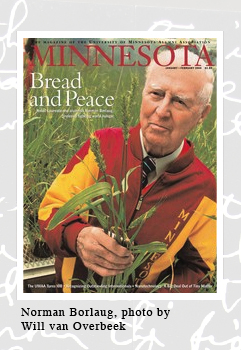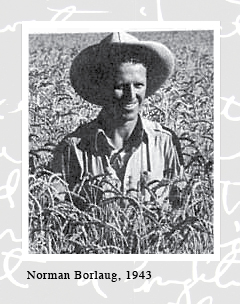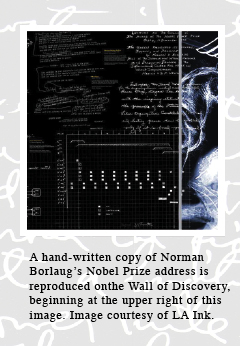As told to Vicki Stavig, originally published in Minnesota magazine, January, 2004.

I want to die with my boots on. I will be 90 years old March 25 and am still fighting world hunger by helping farmers in several countries to increase their production. Some people say I've saved more lives than any other person in the world, but I take that with moderation. A lot of people have been saved, but my main contribution has been teaching. It was the teamwork of all these young scientists I've worked with that made the difference.
I won the Nobel Peace Prize in 1970, for developing a high-yielding, drought-resistant variety of wheat. When I first heard about it I thought someone was playing a trick on me. I was out in the fields in Toluca Valley in Mexico, harvesting with five scientists from Romania, Brazil, and Mexico, when my wife, Margaret, drove out to find me. She said, "Someone from a newspaper in Oslo called right after you left this morning and said he urgently needed to talk to you. He said you've won the Nobel Peace Prize!"
Two hours later, here comes a car and out climb a cameraman for NBC and a writer for the Christian Science Monitor. They were in Mexico for the Pan American Press Conference and said they saw the news about me come over the wire. They interviewed me and left. Then here come two carloads of Mexican press people. They were mad because the first two guys had paid some kids to give them the wrong directions to where I was.
I gave my Nobel Lecture the day after the award ceremony at the University of Oslo. In essence, I said there is no magic in the variety of wheat alone, but that if economic policies would take care of adjusting credit and fertilizer, it would ensure there would be enough production until the year 2000. It turned out I was about right in my estimate. There are two aspects of food and hunger. One is to produce enough food for people in a country and the other is equitability of distribution. In India, for example, you still see large numbers of people who are badly nourished, but there is an abundance of food in government storehouses because there is a lack of purchasing power.
Today I wear three hats. I am a Distinguished Professor of International Agriculture at Texas A&M in College Station; president of the Sasakawa Africa Association, which is working to increase farm production in Africa; and senior consultant to the director general of the International Maize and Wheat Center in Mexico. I also lecture at universities all over the world.
"When the Nobel Peace Prize Committee designated me the recipient of the 1970 award for my contribution to the 'green revolution', they were in effect, I believe, selecting an individual to symbolize the vital role of agriculture and food production in a world that is hungry, both for bread and for peace."
I grew up on a farm near Cresco, Iowa, 10 miles from the Minnesota border. Originally, my ambition was to be a high school science teacher and athletics coach. I was captain of the high school football team, was on the wresting team, and played baseball. After high school, I didn't have enough money for college, so I stayed in Iowa, but there were no jobs except during the peak harvest seasons.
In February 1933, I entered a Midwest AAU [Amateur Athletic Union] tournament in Cresco. Most of the other entrants were university wrestlers. I hadn't wrestled for a year but got into the finals and wrestled a person from Iowa State Teachers College. He beat me in overtime. As I was leaving, the Iowa coach said, "You should come to Iowa State Teachers College." There were no athletics scholarships at that time, but the coach said he would get me a job.
Shortly before I was to leave for Iowa, George Champlin (B.A. '34), a football player for the University of Minnesota who lived in Cresco, drove up. He said, "My dad said you should be at the University of Minnesota. I'm going to early football practice tomorrow. Come and ride along. You can hitchhike back if you don't like it there." I went and never came back.
I had a good high school academic record, but when I came to Minnesota they said, "You're short a year of credits." At that time Minnesota didn't count ninth grade as high school, so they said I had to take a special exam. I took it and flunked it and figured, hell, I'm a complete washout. But George took me to see Fred Hovde (B.S. '29), dean of the General College, which was just starting. George told him what had happened and Hovde said I should start in General College. I spent fall and winter quarters there and had very good grades, so Hovde said I could transfer to any of the University's colleges. I went to the forestry college.
I started out playing baseball and wresting at the University. I wrestled at 145 pounds and at heavyweight. I had to drop out of baseball because our lab classes were in the afternoon, but in wrestling you could work out anytime. I wrestled for three years and at the end of my sophomore year I had a good record. I think I won nine out of 11 bouts.
I was instrumental in bringing Dave Bartelma, my former high school wrestling coach, to the University of Minnesota. He would put me and another wrestler on a bus and send us to parent/teacher meetings at Minnesota schools to demonstrate wrestling. Eventually the sport caught on in high schools. Later, when I was in graduate school at the University, I was the freshman wrestling coach and I refereed the first Minnesota State High School Wrestling Tournament in 1938. I was inducted into the National Collegiate Hall of Fame in 1992, and in 1994 I was inducted into the University of Minnesota National M Club Lifetime Achievement Hall of Fame.
I didn't have money, so occasionally I dropped out of school to work. There were all sorts of emergency programs under President Franklin Roosevelt. I worked for the U.S. Forestry Service off and on from 1935 to 1938. The University gave me a good, broad foundation. I also met my wife, Margaret, at the University, where she was studying education, and we married in September 1937. Her brother, George Gibson (B.A. '30, Ph.D. '34), was captain of the football team and is now 98 years old.
One day I saw a notice on the bulletin board about a talk by University plant pathologist E.C. Stakman. I went and was very impressed and said, "If I ever have a chance to go to graduate school, I would like to study under him." When I heard him speak, it changed my life, my whole career.
I got my degree in forestry in 1937 and was scheduled to go on a permanent assignment with the forestry service on January 1, 1938. But I got a letter from them asking me to delay it until the first of June. So I studied under Stakman, and that changed everything. I got my master's degree in plant pathology in 1939 and my doctorate in 1942. The University had a good, active breeding program for flax, and I worked on that with J.J. Christensen, who was my major professor in the doctorate program.

In 1942, I accepted a job as a microbiologist with the DuPont de Nemours Foundation. I was supposed to work on agriculture chemicals, but war broke out so we worked on evaluating and testing a variety of materials that were used by the armed forces in the tropics. Then in September 1943, the Rockefeller Foundation came to me and said, "We hear you have the background of experience and training we need to start a program with the Mexican government to develop technology for food-deficient countries and to train their scientists." This was a new program that was funded by the Rockefeller Foundation to assist poor farmers in Mexico and to help them increase their wheat production.
So I moved to Mexico. Other than a couple of days in Canada, I had never been out of the country. We lived in Mexico City, because there were English-speaking schools there. When we moved, my daughter, Jean, was a year old. My son, Bill, was born in Mexico. When he was growing up, I helped to organize Little League baseball and spent a lot of time on it. I would leave the experiment station Friday afternoon and drive 300 miles home on miserable roads. I would get home at one or two in the morning, and we would have games on Saturday and Sunday. Then I would drive back to the station.
Initially there were language problems, bad working conditions, and bad food because of the lack of refrigeration. Several times I wished I were back at DuPont. I thought I had made the wrong choice, but then the doom and gloom began to lift—and I'm still there. I go to Mexico the second week of January and stay until the end of August each year.
That program evolved into the International Maize and Wheat Improvement Center, an international research and training institute with 16 independent centers that are scattered around the world. I was put in charge of coordinating all the research going into wheat, and I worked on soil fertility too. Some of the soils in Mexico had been cultivated since long before the Spaniards came to Mexico, so they were at a low level of fertility and we developed methods of fertilizing that soil.
We trained Mexican agriculture scientists and bred high-yield dwarf wheat that resisted a variety of plant pests and diseases and that yielded two to three times more grain than traditional varieties. That wheat sparked what came to be known as the Green Revolution, the idea that plant breeding could end world hunger.
Mexico became self-sufficient in wheat production in 1956, but no longer is because it had 22 million people when I first went and now has more than 100 million people. In 1959, I turned the Mexico program over to the Mexican government. Then the Rockefeller Foundation and the Food and Agriculture Organization of the United Nations sent me to several countries—including Egypt and other African countries, Iran, Iraq, India, and Pakistan—to see if there was a need for what we had learned in Mexico. I said, "Pick the best people getting degrees from universities in these countries and send them to me in Mexico. I would like to train them for a couple years."
In 1960 we expanded the program and began to teach farmers in Pakistan and India to cultivate the new wheat. I also told the young scientists there, "I don't want to teach you to be rebels in your scientific approach. Don't try to change everything all at once." You have to be sensitive to the politics of the country.
There was criticism about what we were doing. Back home in the United States, some of our worst critics said nothing could be done in India with the population and lack of education there. There were predictions of doom and gloom. The Pakistan-India war in 1960 also caused some problems for us. At two different points, I was the only contact between those two countries.
Pakistan's scientists started coming to Mexico for training in 1960, and in 1968 Pakistan became self-sufficient in wheat production. Pakistan increased its wheat production from 4.6 million tons in 1965 to 8.4 million tons in 1970. In 2000, it produced 21 million tons of wheat. India became self-sufficient in wheat and rice in 1972 and by 1982 even became a modest exporter. Wheat production in India increased from 12 million tons in 1965 to 72 million tons in 2002.
The use of high-yield technology has helped farmers produce higher yields on less land and has saved millions of acres of forests and wildlife habitats. In 1960, the world's grain output was 692 million tons. Four decades later it was 1.9 billion tons. That's a threefold increase using the same amount of land. Had you tried to increase that production using the technology of 1960, you would have had to cut down an additional 1.1 million hectares—a hectare equals 2.5 acres—so what was saved was 1.1 million times 2.5.
I never promise much when I go into a new country. I say, "Let's see if we have technology that will fit." It takes two or three years to get a feel for it, to see if it will work. If that technology will only increase yields by 10 or 15 percent, that would be a lot for U.S. farmers because they produce so much, but if you're near starvation, it's nothing.
I retired in 1979 and was going to be a visiting professor at the University of Minnesota. I taught for one fall quarter and worked the rest of the year in forest genetics for Weyerhauser Timber Company. Then, in 1981 my successor at the International Maize and Wheat Center in Mexico died, so I returned to run that program. I continue to work there as a consultant to the director general.
In 1984, I got a call from Ryoichi Sasakawa, chairman of the Sasakawa Foundation of Japan. He wanted to know if the Green Revolution's agricultural methods could be applied to parts of Africa that were suffering from drought and famine. I said I was too old to start something new. I said, "I've never heard of those countries," and hung up.
The next morning, he called me back. "Young man," he said, "I'm 15 years older than you are. We should have started his project yesterday, but let's get started tomorrow." I accepted. Ryoichi Sasakawa died five years ago, but I'm still president of the Sasakawa Africa Association, which is working to spread the Green Revolution to Sub-Saharan Africa. We have projects in 10 African countries. This is the toughest part of the world because it doesn't have an infrastructure. It had tremendous corn crops in the upper elevations, but people were starving in the lower elevations because there was no way to get the corn to them. There were no roads, no railroads. We could double or triple production in some areas, but the cost of bringing in fertilizer is three to four times what U.S. farmers pay.
Lack of roads is a major obstacle. It hinders agriculture, education, and development. Roads bring schools and public health workers, break down cultural barriers, and reduce fear. If you build a road that crosses tribal groups, those people begin to see others and realize that they are not so different from each other.
Over the years, I've learned much about agriculture. I've also learned much about people. Some of it I didn't want to know. I learned there is a fear of change, whether it's in agriculture or anything else. Especially as you move upward in income, there seems to be an innate fear in some people that someone might tip over their canoes—and those canoes are pretty comfortable. This is widespread, and it's dangerous. In developing countries, people in power will say it's too risky to change things because they've struggled to get their positions and, if change fails, they will be held responsible. You have to have courageous leaders.

Hunger and peace are interrelated. Have you ever been hungry—hungry for three or four days? One needs to have that experience. When people are hungry, it disrupts everything. If you were hungry and your children were starving, you would breach the laws pretty easily. You would steal for those children. When you have poverty, hunger, and misery, it's easy to plant terrorism and all other kinds of "isms." The world has shrunk. We can't ignore these problems.
I have been awarded the Nobel Peace Prize and have received honorary degrees and achievement awards from many universities around the world, but I am most proud of training young scientists to attack these problems in food production and to have seen some big changes.
But millions of people still are undernourished in the world today. Predictions are that the world population will reach about 8.3 billion by 2025. In order to feed those people, I calculate that we will need 1 billion more tons of grain. That means more tons per hectare are needed. There is much work that still needs to be done.
Related Links: